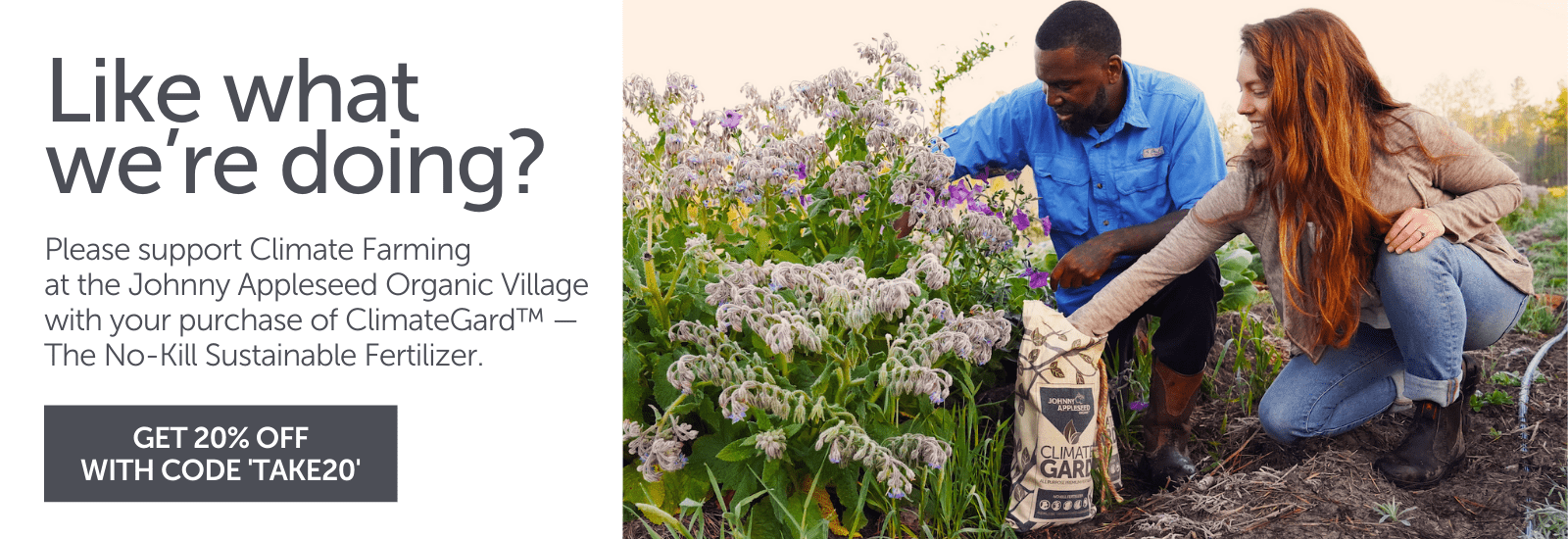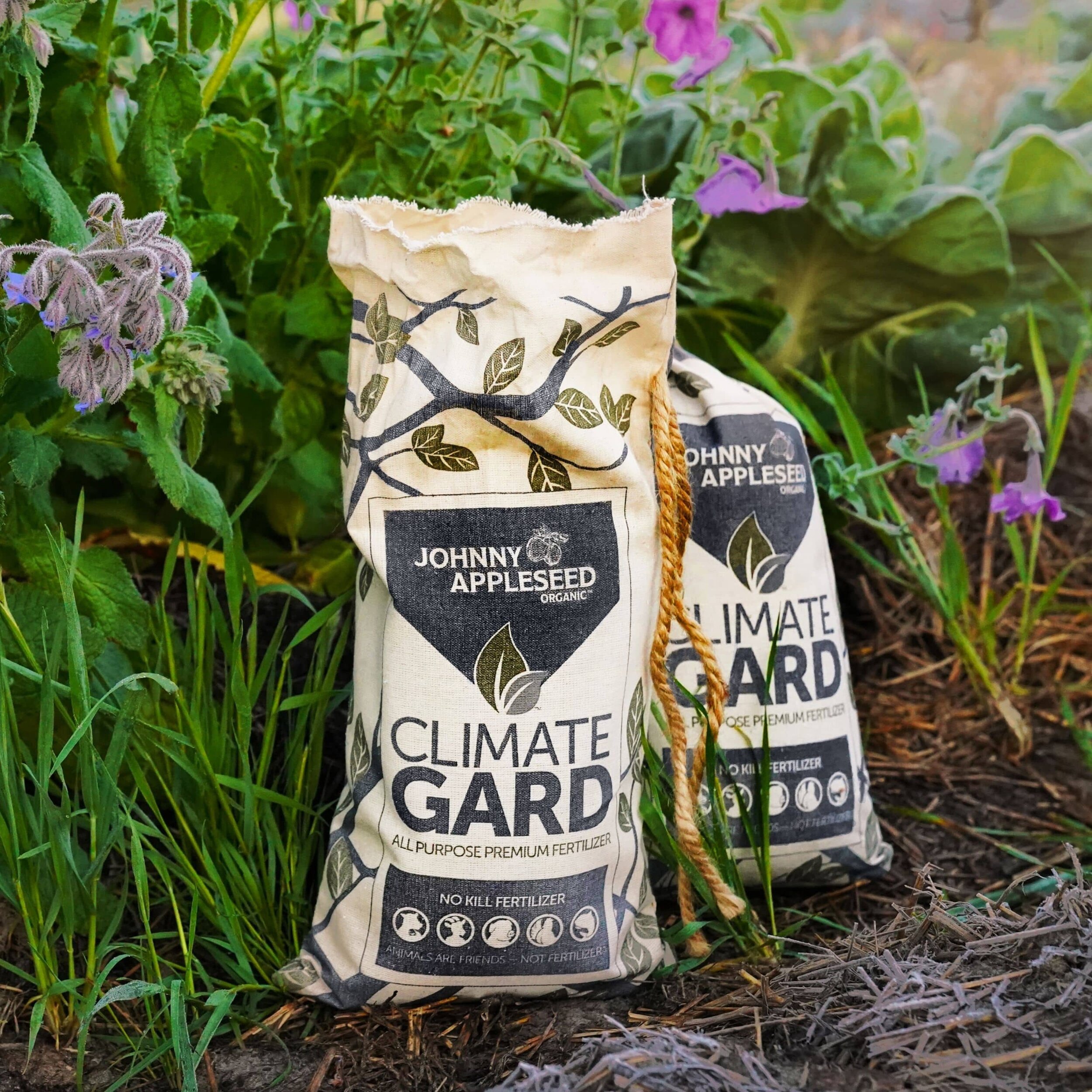Natural Succession & Stratification in Climate Farming Practices
By Mikael Maynard
Growing food in a way that mimics nature helps us in our effort to grow a wide range of fruits and vegetables while naturally mitigating pest pressure, producing our own fertilizer, and improving soil quality. To do this, we focus on designing food, fodder and fertilizer growing systems that are strategically implemented through time and space, viewed through the ecological lense of natural succession and stratification.
Natural succession and stratification are intertwined and incorporated on the climate farm in ways inspired by the pioneer of syntropic agroforestry, Ernst Götsch, and under the design framework of permaculture, as originated by Bill Mollison and David Holmgren.
Growing Through Time with Natural Succession
There are two forms of succession: primary and secondary succession. Primary succession refers to the colonization of a primitive substratum (a new island made by volcanic activity, for example) by a community of plants, animals and fungi, which can take a very long time to reach climax or a state of equilibrium.
Secondary succession refers to the regrowth of some remnant species within a new community of plant, animal and fungal organisms after a devastating event on what was previously land at climax. Examples of devastating events that would spur secondary succession include anthropogenic influences such as deforestation, as well as natural influences like floods and fire.
Secondary succession takes considerably less time since the soil holds a bank of seeds from the previous vegetative community. Nature’s weedy pioneer species mix with these species to restore and stabilize a new naturalized community of climax forest.
As climate farmers in the 21st century, the form that concerns us the most is secondary succession, since much of the land on earth has been drastically altered by humans and climatic factors. In the case of the climate farm at the Johnny Appleseed Organic Village, we are working land that has been deforested, and cyclically planted with timber pine monocrops for many generations.
What’s left is a whole lot of mismanaged soil and a barren landscape, so the process of natural succession guides our farm plantings as we look to rehabilitate our soils, produce biomass and grow fertilizer while simultaneously growing food.
Combining the ethics, principles and practices of permaculture with the production framework of syntropic agroforestry, we are essentially speeding up secondary succession. This is done by strategically planting certain species of plants that are prevalent throughout the three stages of succession in a shorter timespan.
According to the Encyclopedia Britannica, the three stages are:
Pioneer species - These are species that can grow in the harshest of conditions with very poor soils and require little attention and create the foundation for a forest to build off of. In the agroforestry world, this includes plants such as annual groundcover, grasses, and some short, medium, and long-term perennials.
Intermediate species - These are species that are able to grow once a generation or two of annual and perennial pioneer species have grown and died. The pioneer species have added biomass and nutrients to the soil, restoring some water retention, and provide a form of nursery for intermediate species. These species are mostly perennials with longer lifespans. In the agroforestry world, this includes plants such as fruiting species as well as biomass creation species.
Climax species - These are species that are able to grow once pioneer species have more or less phased out and some intermediate species grow to produce a community of mature plants. In the syntropic agroforestry world, this includes a consortium of plants that provide food, fodder, and fertilizer growing in harmony with each other, each filling a unique layer of a forest.
As Ernst explains, “Space (stratification) has to be harmonized over time (life cycle), respecting the successional steps (Placenta, Secondary and Climax) within each of the Systems (Colonization, Accumulation and Abundance), according to Ernst’s definitions. A syntropic agroforestry, therefore, evolves and transforms over time and space, always “towards the increase of quantity and quality of consolidated life”, says Ernst.”
Before we move on to species selection, let’s first look at how stratification intertwines with succession.
Growing Through Space with Stratification
Quoting again from Encyclopedia Britannica:
“Community structure can become stratified both vertically and horizontally during the process of succession as species become adapted to their habitat. Gradations in environmental factors such as light, temperature, or water are responsible for this fractionation. The vertical stratification that occurs within forests results from the varying degrees of light that the different strata receive: the taller the plant and the more foliage it produces, the more light it can intercept.”
With this in mind, we want to plant species that follow the path of natural succession, while simultaneously varying the species to hold different stratas. As permaculture designer Angelo Eliades writes:
“By planting in all the layers of a forest at the same time, we can instantly create the multi-tiered structure and we don’t have to wait for each step to complete before the next one can commence. This way, we can speed up the process of forest succession immensely, and create an established forest in no time at all.”
There are seven primary layers of a forest described in permaculture literature. They are:
The canopy layer
Sub-canopy layer
Shrub layer
Herbaceous layer
Ground cover layer
Underground layer
Vertical / climber layer
There is an eighth layer specific to the tropics which is:
Emergent palm layer
There are also two rogue layers:
Aquatic layer
Fungal layer
Now that you know what natural succession and stratification are, it’s time to explain how we grow food with these concepts in mind.
How We Apply These Concepts On the Climate Farm
Imagine a clearing in the pines with just bare soil exposed to the sun. The first step we took before planting in this space was installing earthworks on the site, including swales and tree rows on contour to passively capture water and create an ideal space for planting.
After installing earthworks, it was time to start the first stage of successionary plantings: pioneer species sown as cover crops. We chose several:
Grasses
Oats — a short term, annual, pioneer species that fills the herbaceous layer.
Sprawling legumes
Hairy vetch — a short term, annual, pioneer species that fixes nitrogen and fills the ground cover layer.
Blaze winter pea — a short term, annual, pioneer species that fixes nitrogen and fills the ground cover layer.
Large rooted plants
Daikon radish — a short term, annual, pioneer species, useful for plant-powered tilling and occupying both the underground and shrub layers.
Once the first pioneer species have taken root and begun to grow, we planted large clumping grasses at the edge of the swale berm to stabilize the edge and absorb moisture. These grasses include:
Napier grass — a medium term, perennial (3-5 years) pioneer to intermediate species that produces biomass and can be pruned to hold the herbaceous/shrub layer.
Fakahatchee grass — a medium term, perennial pioneer to intermediate species and biomass producer, pruned to hold the herbaceous/shrub layer.
With the soil stabilized and some biomass production underway, we planted a consortium of fruiting species, biomass producing species and nitrogen fixing trees directly into the cover crops.
The word ‘consortium’ comes from syntropic agroforestry and is used to describe an organized pairing of plants that are planted such that their stratas do not interfere, all plants get an appropriate amount of sun and are able to receive nutrients from others who are planted specifically for that purpose. We chose varieties that work well in our climate and hold multiple stratas.
Fruit trees
Pecan — Cape fear: long-term, perennial (300 years), climax species, canopy layer.
Citrus — Satsuma: medium term, perennial (50 years), climax species, sub-canopy layer.
Blueberries — Rabbit eye: medium term, perennial (25 years), intermediate/ climax species, shrub layer
Biomass producers
Eucalyptus macarthurii — Jersey girl: medium term, perennial, intermediate species, used for biomass production, pruned heavily to hold the sub-canopy layer
Bananas — Orinoco and Tall namwa: medium term, perennial, intermediate species, used for biomass production, pruned heavily, sub-canopy layer
Nitrogen fixers
Black locust (Robinia pseudoacacia): long term, perennial, pioneer/ intermediate species, nitrogen fixing, used for biomass production, pruned, canopy layer
Jerusalem thorn (Parkinsonia aculeata): medium term, perennial, pioneer/ intermediate species, nitrogen fixing, used for biomass production, pruned, sub canopy layer
Black wattle (Acacia mearnsii): medium term, perennial (20 years), pioneer/intermediate species, pruned, sub canopy layer
Silver wattle (Acacia dealbata): medium term, perennial (30 years), pioneer/intermediate species, pruned for biomass, sub canopy layer
Why so much pruning?
You’ve probably noticed many of these species require intensive pruning. This is entirely intentional. As Dawn Berkelaar says, “Intense pruning is a unique aspect of syntropic farming (overstory species are sometimes pruned, removing up to 95% of biomass!). Prunings are used as mulch and provide many benefits such as suppressing weeds, feeding soil microorganisms, and aiding in temperature and water management. According to Götsch, extensive pruning at strategic times also accelerates growth. He hypothesizes that when plants are pruned during their growing stage, they release plant growth hormones into the system that encourage nearby plants to grow more quickly.”
The goal of incorporating these techniques into our farming systems is to build what notable systems ecologist Eugene Odum described as, “...a stabilized ecosystem in which maximum biomass (or high information content) and symbiotic function between organisms are maintained per unit of available energy flow.”
A well planted system becomes vigorous and provides its own nutrients (fertilizer) and continually builds soil. It is always a good sign if pests stay away, but as Ernst explains, “We treat those considered to be pests or diseases as indicators of weaknesses in our plantations, caused by mistakes made by ourselves. Errors committed in the design or management of our agroecosystems. We look at pests and diseases as indirect allies, members of the immune system of the macro-organism life on planet Earth (which we are part of).”
Conclusion
As members of the aforementioned macro-organism, we want to grow food in synchronicity with the laws that nature provides. In the long run, the time, thought and energy put into incorporating concepts like natural succession and stratification into your farming and gardening practice will promote regeneration of the soil and growth of the landscape beyond comparison.
Sign up for Newsletter
Follow Us on Social
Cutting-edge microbiology
No kill formula
Superior plant nutrition derived from the most ethical, sustainable sources available.
Produces the same results as conventional fertilizers without the negative environmental impacts.
Each ClimateGard pellet is infused with micronutrients, silicon, humic acid and a high-performance blend of living bacteria and fungi.
Delivered in an environmentally friendly organic cotton bag with a compostable inner liner.
Will continue to enrich your soil long after application.
$39.95 for 7.5 pound bag | $69.95 for 15 pound bag.






